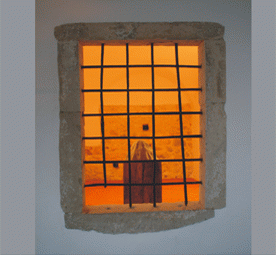
Temporary Exhibitions
Lapidarium

exhibitions
2023
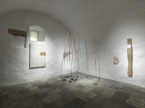
Rudi Benétik: Spontaneous Ambience
Lapidarium, 15 September 2023 - 17 March 2024
Benétik is a telling stories made up of intertwined fragments of reality, such as pieces of packaging and useful objects, used napkins or a t-shirt found on the side of the road, which make up the artist’s experiential world, full of memories of journeys to distant and, for us, exotic lands. The collage technique allows him to freely construct paintings and sculptures, so that they become jigsaw puzzles of feelings from circles of thoughts and experienced everyday life. His works are dynamic, free from the delineated frames of the artistic field, as they generally extend beyond the edges of the canvases to the sides and supports.
Rudi Benétik pours his intimate memoir into each of his works, so a walk through his exhibition is like an artistic journey through the personally confessional diary entries of the restless traveller “Marco Polo” of our time. The fascinating stories he tells us about the most mundane experiences, or about faraway lands and their people, are enriched with reflections and fragile reflections of the world. The lyrical lightness of Benétik’s works thus seduces the viewer into an ambivalent world of visual sensations, imbued with the subtle sensations of the fan of human emotions, daydreams and memories, with one foot firmly planted here in the physical world, and the other plunged into the depths of the unconscious and the dreamlike.
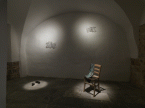
Metka Kavčič: Fragile World
Lapidarium, 21 April - 25 Avgust 2023
Metka Kavčič‘s sculptural works are characterised by the integration of traditional design values and contemporary sculptural approaches. The ambient installation entitled Fragile World connects the varied spaces of the exhibition centre with deeply confessional works of art characterised by a play of contrasts, clear narrative and reinterpretation of often discarded objects placed in a new context. With thoughtful interventions in the space and, at times, purely theatrical placements, the artist emphasises the coherence of the entire concept of the installation, which forms a narrative arc.
The artist first invites the viewer into a kind of fairy garden, where she reveals the beauty of the intriguing vegetative patterns that her skilled hand has carved out of two pieces of ordinary rolled sheet metal. The inferior metal, seemingly floating in space before our eyes, comes to life through shadowy reflections and becomes something elegantly poetic, dynamic and fragile. Sheet metal, iron and bronze, and, for the first time in her oeuvre in this exhibition, plastic, mimic the light feeling of wrinkled and crumpled fabric or, even more delicate, the ornamental patterns of threads interwoven into delicate lace. Testing to what point you can take a material to get the most out of it, to seemingly bring out qualities that are not its own and that we don’t associate with it, is one of the fundamental building blocks of her artistic language.
2022
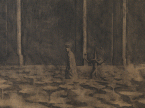
Erik Mavrič: Long Black Summer
Lapidarium, 23 September 2022 - 15 January 2023
Umetnik Erik Mavrič s svojo samostojno razstavo Dolgo črno poletje pripoveduje zgodbo o kratkovidnosti in samoumevnosti sodobne družbe in s tem povezanimi eksistencialnimi tegobami posameznika, ujetega v vzorce družbenih normativov. Za razstavo je ustvaril povsem nova dela, ki so bila že osnutkih zastavljena in prilagojena specifičnemu razstavnemu prostoru lapidarija v Galeriji Božidar Jakac. Dela predstavljajo (samo)ironično grotesko in humoresko, kjer je v glavni vlogi vselej človek.
Mavrič je eden najbolj enigmatičnih domačih ustvarjalcev, saj se v svoji skrajno raznoliki umetniški praksi navezuje na številne tehnike, žanre in tendence iz zgodovine in jih umešča v polje sodobne umetnosti; njegovi izrazito sodobni in aktualni motivi se med drugim napajajo pri socialnemu realizmu, ekspresionizmu, nadrealizmu, kubizmu in stripovski produkciji. Pričujoča dela so ustvarjena na lesenih nosilcih, na katere je Mavrič risal z ogljem in tako ustvaril kompleksne, obsežne in podrobne kompozicije, ki prinašajo skrajno temačno in hkrati humorno pripoved o svetu tukaj in zdaj, kakor tudi v bližnji in daljni prihodnosti. Risbe so apokaliptične in se izrisujejo v luči resigniranega pogleda v bodočnost, kjer se vsakdanji pojavi sprevračajo v grotesko. V tem pogledu je razstava Dolgo črno poletje svojevrstna sodobna interpretacija motiva ladje norcev, kjer se potniki krhkega splava brezglavo predajajo mesenim užitkom, kar umetnik primerja s stanjem duha sodobnega sveta. Vsi ti premisleki so danes še vedno (ali ponovno) prisotni v družbi, saj se ideja po bolj odgovorni in pravični globalni družbi (še) ni uresničila. Zato se Mavrič v pričujočem ciklusu ne ozira v preteklost, ampak zgolj analizira sedanjost.
Erik Mavrič (1979) is a visual artist who primarily works in the medium of drawing. He studied painting at the Academy of Fine Arts and Design in Ljubljana where he graduated in 2004 and completed MA programme in 2008. During his studies in 2002 he received student Prešeren Award, and in 2012 he was awarded special acknowledgement of the jury at the 16th Slovenian Sculptural Exhibition. He showcased his works on several solo exhibitions, among others at Galerija Krško (2014), Galerija Alkatraz in Ljubljana (2018) and DoubleRoom arti visive Gallery in Trieste (2018), as well as on several group exhibitions. Mavrič lives and works in the vicinity of the town of Krško, Slovenia.
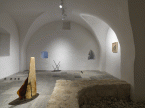
Paola Korošec & Aleksander Nišavić - Aco: ADSUM
Lapidarium, 1 July - 4 September 2022
The joint exhibition of sculptor Paola Korošec and painter Aleksander Nišavić – Aco in the venue of lapidarium is interweaves the works of both artists that by applying different artistic media tell the story about transience, memories and captured moments of life. The common interest of both artists is experiencing place and time from the point of view and perception of an individual. They have in common special affinity for medieval architecture and sculpture as they both work as professional restorers.
The greatest constant of our lives is eternal process of change, instability, fluidity of the body shapes and consciousness. The exhibited works incite immersion into the nostalgic stroll across the landscape of experienced memories; the common thread of the show is the idea to connect rich cultural heritage of the former Cistercian monastery with contemporary art and to allow for reflection of seemingly immense distance between then and now.

Vegetation: Nika Erjavec, Tina Konec, Tea Kralj, Tilyen Mucik
Lapidarium, 8 April-19 June 2022
The group exhibition Vegetation showcases the works created by four visual artists, who, in their work, focus on various aspects of depicting and treating nature through the art perspective. In their practices they address the relation of mankind towards the natural environment, which has inevitably been demonstrated and reflected in the dominant visual culture and art in the past, as well as during the present times.
Even though numerous civilisations have, during the course of history, managed to establish an apparent division between wild nature and man-made culture, the mentioned distinction is today viewed as forced and skilled. However, nature has always represented an inspiration for culture and art, as these have always summarised its forms, structures and manner of operation. The attitude people have towards the natural environment has always been two-faced: on one hand it has been extremely competitive, as we always had the desire to subdue and control nature, while on the other hand, the relation has always been symbiotic as people always viewed nature with special admiration and awe. The works shown at the Vegetation exhibition thus reflect deep attachment and connection of the participating artists with everything earthly, which is to a great degree visible in their diverse use of vegetative or plant elements. The four artists show extreme diversity in their artistic practices: Nika Erjavec presented a new media spatial installation, Tina Konec showcased a series of large format drawings, Tea Kralj a series of paintings and Tilyen Mucik focused on a selection of photographs in an expanded field. In their lucid, engaged and multi-layered artistic practices the artists reveal the human dependency on nature and the environmental afflictions of the contemporary world.
2021
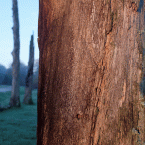
Darije Petković
Damnatio memoriae
permanent collections, 8 October 2021-27 February 2022
The exhibition Damnatio memoriae by the Zagreb based photographer and artist Darije Petković addresses the ways in which we constitute our memories through visual means. The artist uses the medium of photography to show his personal view of the cultural landscape marked by numerous historic events and inscribed into the collective memory through public and media discourses. The works from his current series lucidly follow and comment upon the consequences of the social, ideologic and economic transition in Croatia as well as throughout the broader region.
Over the past fifteen years Darije Petković focused on the role of photography as an important culturological category that can be used to show social reality by depicting the cultural landscape. Photography is often linked to the experience of time and space, both of which are witnesses to historic memory. Since the disintegration of Yugoslavia thirty years ago, Croatia remained a transitional society that is, similar to the post-World War II society, marked by the rejection of social values from the previous period and historic revisionism. Such breaks in the continuity on all levels of society have eliminated numerous positive achievements and events from the previous times, which have been substituted by an immense void. Already Petković’s previous works (such as Okupacija u 26 slika (Occupation in 26 Pictures, 2008), Zagrebačke tvornice (Zagreb Factories, 2010) or Duhovi prošlosti (Ghosts of the Past 2008-2013)) revealed the pathologies of politically motivated historic constructs. Through photographs, objects and archive material, which he uses to construct a coherent narrative of the relativity of historic facts and their dependency on the current political discourses, the series Damnatio memoriae (2019) continues with his research into the ways we relate to the past. The artist chose six symbolic locations (from the famous uvala Slana on the island of Pag to the political school in Kumrovec) that marked the semi-recent past as the central points of this series.
The exhibition emerged in cooperation with the Vladimir Bužančić Gallery, which operates within the Novi Zagreb Cultural Centre, where the exhibition Damnatio memoriae was presented for the first time in 2019. The exhibition was curated by Anita Zlomislić.
The exhibition will be on display until 2 January 2022.
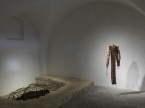
Lea Culetto & Tajda Novšak
Everyday Restraints
Lapidarium, 27 August 2021-2 January 2022
The exhibition Everyday Restraints is a dialogue between the works of two young female artists, Lea Culetto and Tajda Novšak, both of whom have created a name for themselves on the Slovene art scene with their insightful and creative practices. Their works are connected through their thematic questioning of the integration of the individual and his feeling of being trapped by social restraints, norms, rules and expectations that can lead to long-term consequences.
The works created by Culetto and Novšak are presented parallelly, simultaneously and in a constructive dialogue, as their site-specific and unique works intertwine and communicate in the diverse exhibition rooms of the Lapidarium. Even though their artistic practices are explicitly individualistic and unmistakably recognisable in the formal and technical sense, they often address similar issues. Both artists address the ever-present integration into the various norms and restraints that are thrust upon us by society, regardless of whether this is linked to our appearance or the imperative of success. Lea Culetto presents colourful, almost saturated images and spatial installations created from everyday materials, predominantly textile, with which she addresses the omnipresent social anomalies rooted in social gender and status. The works of Tajda Novšak, in the form of spatial, robust and dark sculptures, reflect the feeling of entrapment into the various social ties and conventions that are thrust upon us.
Curator: Miha Colner

Re/Forma viva
Exhibition Commemorating the 60th Anniversary of the Int. Symposium of Sculptors Forma Viva
Božidar Jakac Art Museum,, 4. 7.-26. 9. 2021
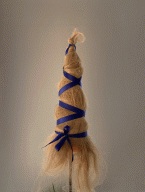
Eva Sajovic: Hanging By a Thread
Hanging By a Thread
Lapidarium, 7 May-1 August 2021
Eva Sajovic: Hanging by a Thread
7 May -1 August 2021
Eva Sajovic’s solo exhibition Hanging by a Thread is an overview of her artistic and socially engaged work that she had created over the past five years, during which she has been primarily focusing on pressing environmental issues. The contemporary global society is confronted by ever-faster climate changes, which have direct as well as indirect consequences on the everyday lives of people, as they lead to migrations, ideological violence and changes in work patterns.
The exhibition Hanging by a Thread revolves around three ongoing works, which Sajovic has been developing since 2015 with various visual art, performative and educational approaches focused on the phenomena of increased climate instability and environmental initiatives linked to this: Ecology, Picturing Climate and All Rise for the Planet. Sajovic also created an entirely new artwork for her exhibition at the Božidar Jakac Art Museum, which is linked to the aspects of local ecology and cohabitation with the environment. In her work, the artist has been combining art, anthropology, independent reporting and ecology, with which she has been trying to draw attention to the unsustainability of the currently dominating principles of constant growth of production and consumption and the slump caused by the domination of economic interests over people and the environment. She created an environmental ‘site-specific’ installation, which presents socially engaged works in a completed body of works consisting of photographs, moving pictures and spatial installations.
The exhibition is a part of the international network project Overview Effect that, on the initiative of curators Zoran Erić (MSUB) and Blanca de la Torre, connects number of museums and institutions from all over the world in addressing connections between contemporary art and environmental issues.
Eva Sajovic (1976) is an artists and pedagogue, who is currently a full professor at Camberwell College of Arts and Chelsea College of Arts in London, but also works as an academic researcher, environment activist and independent artist. In her artistic work she focuses primarily on contemporary social issues, climate changes and their influence on the lives of people, social stratification and migration.
2020

New Era
PLATEAURESIDUE, Maja Smrekar, Robertina Šebjanič, Tanja Vujinović
Lapidarium, 28. 8. -1. 11. 2020
The New Era exhibition showcases works of three artists and one artist group from Slovenia who, in their creative practices, consistently and continuously address the relationship between human and nature. The selected works provide a profound contemplation about anthropogenic interventions into natural environments and about current sociopolitical and economic structures of governance which are based on principles of infinite growth of production and consumption.
The exhibition at the Lapidarium attempts to establish a dialogue between conceptually diverse works of the PLATEAURESIDUE collective, Maja Smrekar, Robertina Šebjanič and Tanja Vujinović. By using different means of visual art making these artists are commonly dedicated to exploration of topical issues of modern age such as comprehension of natural environments, need for colonising nature and analysis of environmental policies that are nowadays still firmly based on the concepts of modernisation and development. In the history of modern and contemporary art, since the emergence of industrial revolutions, ideas and works of artists often touched upon phenomena of natural environment but only on the level of representation; however, in the past decades some artists took on more active role and started to relate their artistic practices with scientific and other interdisciplinary discourses. This particular orientation is summarised with this group exhibition showcasing highly analytical and engaged creative responses of artists to topical issues such as the world’s ecology, consequences of interventions in the environment, relationship between human and non-human, overcoming the culture-nature dualism, and the future of humankind.
Curator: Miha Colner

Armando Marrocco
To Exist is to Exist
Lapidarium, 20. 6. - 9. 8. 2020
Painter, sculptor, performer and versatile artist Armando Marrocco (1939, Galatina) moved from southern Italian Apulia to Milan in 1962, where he remains to this day. He was initiated into art circles by the influential Italian painter and founder of Specialism Lucio Fontana. Marrocco collaborated with many prominent names from the 60s to the 80s, was a cofounder and member of Italian art groups and a performer who played with fire etc. He was influenced by the French critic and philosopher Pierre Restany and the artist Yves Klein, the founders of the New Realism. In his rich career, the vital Italian bard has realized many projects outdoors, in contemporary galleries, as well as in churches and monasteries throughout Italy. He has received numerous awards for his contribution to contemporary Itali-an art and participated at the Venice Biennale.
The exhibition in the Lapidarium, where displayed artworks range from the 1960s to his recent works, could be described as a mini retrospective. The artworks composed from a variety of natural and artificial materials, which the artist sensibly designs, combines and adapts to his vision, are characterized by a Mediterranean sense of beauty. They reflect the author’s dialogue with the sunny and sea areas, with quotations from archaic civilizations and humanistic, almost Platonic messages, which can be seen in the titles of some artworks. Despite its conceptualist and postmodernist elements, Marrocco presents himself to us as a classic and skilful craftsman, as a sentient individual and aesthete who listens to cosmic creation, marvels at it, and allows it to shine through colourful and optimistic expression. Taking into account the material, visual and substantive dimensions of an individual work of art, it provides us with stories that are interweaved also in a specific summer and place during this installation. We hear, see, and perceive them as exciting illusions, symbols, and archetypes that sail beyond our subjective experience of time and space.
Curator: dr. Robert Simonišek
2019

Svetlana Jakimovska Rodić
Made in Forest
Lapidarium, 12. 7. - 3. 11. 2019
The graphic artist and MA Svetlana Jakimovska Rodić (1965, Kumanovo, North Macedonia) presents on her solo exhibition Made in Forest a series of monotypes and installations. For matrices of her works she uses tree bark in which the patterns made by the bark beetles are visible.
The traces of bark beetles are at the same time traces of the destruction of the trees and the birth of new life forms, which people fail to notice, as they are too small and insignificant. The artist’s interest in the “graphic” traces of the life cycle of bark beetles derives from exploring the reasons for the increased number of (invasive) insects, as a result of human irrational interference with nature, unstructured afforestation of monocultures at lower altitudes and climate change.
The lively and visually interesting patterns and traces of the insect’s movements stirred an interest within the artist. She decided to use them as matrices for her monotypes, with which she, paradoxically, revealed the exploitation of nature through an ironic self-analysis, for she “exploited them” in order to create her graphic prints and thus transform them into artefacts. She has merged the prints on paper ribbons into larger graphic installations by weaving and gluing the strips together and created an experimental layout in the site-specific spaces of the Lapidarium.
The works of Svetlana Jakimovska Rodić reflect the civilisation and the world. The story of the bark beetles encompasses the complex situation in which we live, for we can see, that the human mind, which is at the top of the hierarchy, everyday reaches new scientific achievements and develops surpluses and strategies, however, with all the technology at our disposal, we are still no closer to putting a stop to the destruction created by the bark beetle. The message of the exhibition reverberates as a warning of the possible destruction of the forests on the global level, which would inevitably lead to the destruction of mankind and invites us to a deeper reflection and consideration of the consequences of our acts for the future of our planet.
Curator: Kristina T. Simončič
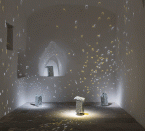
Vera Stanković
Trans-Formations or Farewell Party
Lapidarium, 12. 4 - 9. 6. 2019
It has been seven years since the artist Vera Stanković took part at the group exhibition Ceramics in the Concept 4/2 with the piece I Bake Bread That I Can’t Eat which is the event that also led to the current solo show entitled Trans-Formations or Farewell Party. Hereby the artist showcases six works that address radical transformations that one may experience during various big changes during a lifetime. Four of those works were selected from the existing recent body of work while she created two entirely new works for that occasion. The exhibition is crowned with the installation entitled Farewell Party which announces the artist’s decision to cease her creative work in the field of ceramics.
Curator: Barbara Rupel
2018
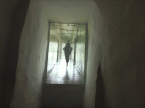
Nataša Prosenc Stearns
Hotel Diary
Lapidarium, 14. 9.-4. 11. 2018
Nataša Prosenc Stearns’s Hotel Diary is a series of photomontage prints and video sound spatial installations, the variations of which were especially created and adjusted to the Lapidarium. For the setting she chose an abandoned hotel with a bar in the business centre of Los Angeles. She used a static camera to film the Hotel Diary, for it makes the footage similar to that of surveillance cameras. Such footage gives the impression of indifference or perhaps neutrality. It is a voyeuristic view of events that are taking place in hotel rooms, hallways and staircases. The Hotel Diary has the recognisable artist’s credo of the human figure placed or interwoven with elements of nature. The artist’s specific editing technique of layering the various shot sequences transforms and abstracts the works. Careful and well thought settings of these videos in to the peculiar Lapudarium rooms, encourages viewer’s sensory or emotional response. The comprehensive artwork is a horizontal interlacement of different stories and their possible associations. By entering and moving around the space, the visitors co-create the dramaturgy of the place with their conscious and subconscious cognitive and sensory processes. By coming in the former monastery pantries, one enters the temporary rooms of the Hotel Diary, a work that can be merged into a film or experienced as independent video-sound installations.
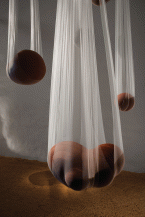
Kristina Rutar
On the Origin of Species
Lapidarium, 20. 4. -24. 6. 2018
Kristina Rutar (1989) is one of few artists from Slovenia who has chosen ceramics to become her central creative medium. This orientation was surely encouraged by sculptor and professor Mirko Bratuša, who was her tutor at the Faculty of Education in Ljubljana, and her tutors at the Academy of Fine Arts in Wroclaw where she later studied. For the solo exhibition at the lapidarium Rutar conceived and created entirely new artistic project entitled On the Origin of Species. It is the continuation of her thorough visual exploration of embryos which nowadays represent the main motif in her art production. In the conceptual aspect of the exhibition, as it suggested in the title, the artist refers to the groundbreaking theories of Charles R. Darwin.
curator: Barbara Rupel
photo: DK
2017
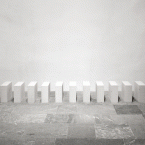
Klara Sax
Carl Andre, Billy and Ethel
Lapidarium, 20. 9.- 26. 11. 2017
The artistic practice of Klara Sax could be inspired by the minimalist sculpture of the 20th century. The artist seems to be using classic modernist references as a starting point to create works which are inspired primarily with the form, with the raw material in the centre of the piece, however, out of that base she develops new, contemporary artistic language. The installation, built from Styrofoam blocks, formally originates from the tradition of minimalism, and it is running uninterrupted through all eight rooms of the venue; furthermore, additional elements of voice narration and sound composition join in in order to incite associations on contemporary irony and humour. Hereby the sublime modernism meets popular culture. How do we understand art work with the respect to an artist? What if an art collective is hidden behind the personal name? What if Carl Andre is a techno musician from Canada? And isn’t the artist Klara Sax the character from the novel Don Delilla?
Curator: Barbara Rupel
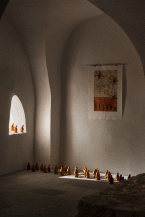
Jožica Medle
The Air You Breathe
Drawing on years of studying and systematically researching history and manifestations of counterpoints in art, analysing the analogue development in music, dance and fine art, Jožica Medle, painter, graphic print maker, designer and PhD holder from the Department of Graphic Prints at the Zagreb Academy of Fine Arts, prepared an exceptional artistic counterpoint on the theme of ecology. She created a series of graphic prints, in which the counterpoint was introduced on three levels – with pervasive mediation of contrapuntal content, with well chosen and harmonious visual language on individual graphic prints, and with the scheme and layout of the exhibition, in which the harmony of individual works forms a story on the highest possible level.
On the primary level the basic elements of Jožica Medle’s graphic prints draw and define the non-mimetic and abstract visual formulations, which have their own opposing voice, their own counterpoint on higher levels. The basic antigens to the earthly abstract organic nature are attached to the expressively existential photo-figuralics and lettrism. The accumulation of fine art elements, points and lines, which are in nature organically necessary and omnipresent, oppose the monochromatic anthropomorphic and zoomorphic shapes of white shadows, black bodies and bodily voids or absences. By contrapuntal layering, stringing and merging the artist created a visual cantus firmus.
(dr. Ines Vodopivec)

Nina Čelhar
Lulls
Lapidarium, 21. 4. - 21. 5. 2017
The solo exhibition entitled Lulls of the painter Nina Čelhar is a consequence of her participation at the biennial exhibition A Look 8 previous year where she received the main award. The important feature of presenting her recent paintings, divided in the four separate sections, is the the specific exhibition space itself. The core of the exhibition is the selection from the artist’s body of work of the past five years in order to point out the constants and developments in her artistic practice. Among the constants one could definitely trace the subject matter inspired by urban landscape such as residential architecture, interiors of houses and decorative plants. In her creative endeavour the artists strives to redefine these everyday objects again and again. Nina Čelhar is therefore often attracted by motifs that evoke notions of silence and solitude; however, in the appearance of her works one can also find a synonym for formal implementation of her constant search of inner peace.
Curator: Barbara Rupel
2016

Mateja Kavčič
Shelters
Lapidarium, 09. 09. - 06. 11. 2016
The story that the artist has imaginatively placed into the exhibition space is full of symbols and intuitive fragments, as well as references to the history of land art. The concept of the exhibition, which is determined already by the title Shelters, is of course not intended merely for itself and the immanent aesthetic component, but also encourages and inspires interaction. This interaction is not limited merely to the visitors, but also spreads to the expressed essence of the natural elements in space, as well as the potential beings that coexist with these elements.These can be either representatives from the animal or the fairy, magical world. Shelters are always constructed for somebody.

Boštjan Kavčič
O/DE
lapidarium, 18.06. - 15.08.2016
The artist deliberately connected the four entrances into a well thought out story, full of interactions and numerous associative attachments, which constantly cross the artist’s thin line of the intuitive and rational field. The viewer can thus experience the wholesome experience of the artistic setting, which incorporates the borders of the spaces. Boštjan Kavčič stated: »The entire history is caught in stone, and this is why I am attracted to it. Every piece has its own story«.

Ignac Meden
U/S/TVAR/I/TVE
lapidarium, 15.04.-30.05.2016
The exhibition of Ignac Meden was organised in collaboration with the Murska Sobota Gallery which is also his domicile gallery. There the artist’s work has been showcased on several solo exhibitions; the last one dates back to the season 2014-2015. For the occasion of this solo show at lapidarium of the Božidar Jakac Art Museum Meden’s works were placed in direct dialogue with the exhibition space itself.
Curator: Barbara Rupel
2015

Irena Romih
Interspaces
lapidarium, 18.09.-22.11.2015
Visual creativity reacts to contemporary society with positivist socialisation. Experiences found in television information, newspapers, books and especially the everyday environment represent a broad spectrum visualisation of virtuality and reality, virtual and real reasons for formation and development, seeming and real motifs and goals, virtual and real contents and qualities of events and occurrences. Getting to know the background is a reward for precision and the desired goal of observation. Imprecision and a non-critical approach limit us to our own pretence. In the conscious and cognitive effects of artistic expression the results are often found in the cross-section between appearance and essence. This cross-section of artistic expression is meticulously presented by Irena Romih.

Mitja Stanek
Techno
lapidarium, 03.07.-06.09.2015
The project that Mitja Stanek (1964, Maribor) has prepared for the Lapidarium of the Božidar Jakac Gallery is based on a spatial installation that literally extends into all the rooms and generates a saturated sensation of our digitalised consumer society. As a site-specific project, the installation would be enough in itself, but precisely in order to show the developmental and study-based axis of the modernist approach, we have decided to include in the rooms a selection of prints ranging in date from the early 1990s to 2014 and a number of Stanek’s sculptures, most of which date from a year or two ago.
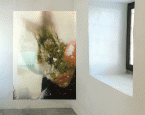
Eva Petrič
4 Particles
lapidarium, 24.04.2015 - 14.06.2015
The exhibition of visual artist Eva Petrič entitled 4 Particles project was designed based on the conditions given by the exhibiting space, a composite of four different, independent rooms with separate entrances. Each room offers a finite whole, while together they represent the integrity of the project displayed. Her artistic practice largely constructs her original poetics based on narrative. The topics of her works are mostly related to the deep, intimate experience of her own existence at a certain time and in a certain space. Eva Petrič (1983) is a multimedia artist who works in wide range of artistic media such as photography, video and spatial installation.
curator: Barbara Rupel
photo: Primož Brecelj
2014
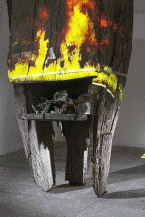
Petar Popijač
Embers
lapidarium, 12.09.-03.11.2014
Petar Popijač (1988, Varaždin) has formulated the project so as to enable us to feel both the historical function of the space in the spiritual sense as well as the material saturation of the constitution of the space in recent times, when oak has begun to play an important role. It is Popijač’s choice of oak as the predominant material in his installation - not just regular oak, but immaculately preserved sub-fossil oak trunks of a characteristic gray colour that were buried deep beneath layers of earth for millennia - that summarises in multiple layers Popijač’s feeling for the timelessness of the former monastery - a spatial context in which the sensual artist is but a reconductor of energy. This time around, it is the selection of material that to the greatest extent defines Popijač’s installation. Conceptually, it is rife with the idea of heat as energy that unobstructedly flows through the material and modifies it in a process that is also inherent in the process of sculpting.
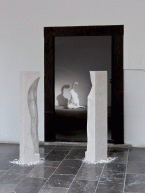
Katja Oblak
The Space of a New Remembrance
Lapidarium, 27.06.-25.08.2014
Katja Oblak (1975) is one of the young sculptors who have found their place within the principle of classic sculpting. Her works are marked by a refined subtlety in choosing her materials of expression as well as by a respect for corporality (object – figure), spatial construction, which she tries to supplement with videos, sound and movement (live or recorded performance on video).
The artist designed this exhibition entitled The Space of New Remembrance for the so-called lapidarium, which always imposes specific conditions on artists with its four sets of rooms with separate entrances in the ground floor of the former monastery. For this reason, Katja Oblak has outlined her exhibiting project as four lines of thought, which relate to each other. She utilises the principle of installation. Each line is made of individual fragments – thought quotations relating to the artist’s personal experience and corresponding to the original topic. The choice of specific material conforming to the idea expressed as much a possible is highly important to the artist. In this exhibition, she has limited herself particularly to white or light materials, such as paper, stone and plaster. In the general perception, white is the closest to the butoh dance, which is Katja Oblak’s vantage point.
Curator: Barbara Rupel

Boris Beja and Suzana Brborović
ID grad.: BB/SB 14 - n. 3/3
Lapidarium, 09.05.-09.06.2014
The message that young artists Boris Beja (1986, Trbovlje, Slovenia) and Suzana Brborović (1988, Kranj, Slovenia) piece together in their socially engaged project bears within itself the full range of diversity of conceptual art, which extends into different theoretical fields, from social philosophy to anthropology. In doing so, it generates critical awareness of the anomalies of our society and times. The project is an exceptionally exacting and mature view into the current zeitgeist: a stark cry, an existential résumé, rife with symbols, from two exceptionally gifted young creators living in time and space, which, along with a social chronology, also captures a moment of self-reflection.
The authors conceptualised their project through a reflection on the construction industry, which is usually among the first sectors to experience considerable collapse in a time of economic crisis. As one might expect in a time of crisis, the subject of labour exploitation is once again very relevant, and is made even more so by the way that the authors also call attention to the state of disarray of work in the visual arts in Slovenia.
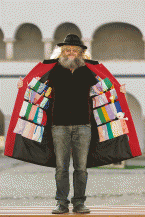
Jože Marinč
Krispan
lapidarium, 21.03.-21.04.2014
Jože Marinč (1954) perceive his works as bearing a part of himself, a brush of his essence, the pulsation of his energy, and the stamp of his identity. When we look beyond the formal properties, no doubt authentic and individualised, his works always carry titles with references to nature and natural phenomena.
It is within this perspective that we argue for continuity in his oeuvre, although the works in this exhibition elude any definition of a medium, art form or art tout court. Even the conceptuality of his installation is too constricting to use because it represses the sensuality and visual harmony as the price for expedience of expression of an idea − it favours intellectual apprehension over the emotional affectation. Marinč would not give up visual properties as the primary means of communication at no price, while he invites the viewer to participate and help his creation work the way he had anticipated. He has collected a series of projects “in waiting” − of the kind that have not yet reached the audience for various reasons, but they are a part of his lab, the alchemist’s study or artist’s warehouse. There they emerged as ideas but for their materialization the two-dimensionality of painting proved inappropriate for teasing the spectator into physical participation.
2013
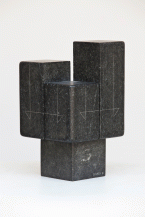
Janez Lenassi
Sculptures in stone
Lapidarium, 27.07.2013-15.09.2013
In terms of both private and creative life, Janez Lenassi (1927, Opatija) was rooted in the ambience of Slovenian Istria and his awareness of this defined his entire sculpting oeuvre. Facing and having the opportunity to examine a selection of decades of Lenassi’s sculptural conceptualization, the pursuit of the creative path of research, analysis and synthesis that he set for himself reveals a creatively unified oeuvre, despite logical evolutionary changes, as well as a unified notional, substantial and communicative dimension, always conditioned by the primordial source of life and all found in nature, which defines his intimate intention in the quality of attitudes to material, space and time.
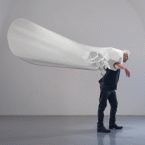
Damijan Kracina
In the Year of Dragonfly
Lapidarium, 31.05.-21.07.2013
Damijan Kracina (1970) started actively working as an artist already in the early 1990s, during his studies at the Ljubljana Academy of Fine Arts and Design. In that period many young artists intensively reflected on ever more pressing environmental and ecological issues in their art works; one of the constant subjects was addressing the possibility of extinction of several animal species. This topic was so central to the artistic work of Kracina that he, in the mid 1990s, created groundbreaking solo exhibition at Kapelica Gallery in Ljubljana entitled Kracina TV. Since then he has consistently dealt with the issue of ecology and extinction of species in his artistic practice, and consequently he has prepared exhibitions such as ZOO, Aquarium, Galapagos, Animal Tour and Sanitarium. In this vein Kracina also conceived his new project In the Year of Dragonfly which has been carefully adapted for the specific venue of lapidarium at the Božidar Jakac Art Museum. The exhibition is thus presented in the style of museum display presenting brand new discoveries of his artistic creation.
Curator: Barbara Rupel
2012

Denis Krašković
My story
Lapidarium, 28.09.-25.11.2012
The exhibition My Story contains works that were created over a long period of time and clearly demonstrate Krašković’s orientation toward figural art that is strongly imbued with Christian iconography and social engagement with current issues. The compositional stories of Postelja (Bed, 1998), Seme (Seed, 2011), Avtoportret z angelom in hudičem (Self-Portrait with an Angel and a Devil, 1993), Rokavice na klin (Hanging Up the Gloves, 2012), and others, executed as both sculptures and drawings, actualize the artist’s intimate reflection on the world, while on the other hand the dialogue with religion indicates his ethical approach to dealing with the world. The compositions with the works Bog je velik (God is Great, 2004), Noji v Afriko (Ostriches to Africa, 2003), Nit v šivanko (Thread the Needle, 2005), and others clearly express the artist’s activist ethical engagement he wishes to tell us about: Friends, this is my story.
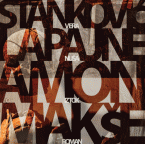
Ceramics in Concept 4/2
Lapidarium, 06.07.2012-02.09.2012
Exhibition curator: Barbara Rupel
The aim of the Ceramics in Concept 4/2 exhibition is to reaffirm the role and importance of ceramics as a specific medium of expression, which appears to various degrees of prominence in works by modern Slovenian artists in their site-specific projects. Four selected artists were invited to conceptualise the exhibition and present their work, each in one of the four different rooms of the former monastery, which we call the Lapidarium today:
Vera Stanković, MA in painting: I Bake Bread That You Can’t Eat
Nuša Lapajne Čurin, MA in painting: Spatial Systems
Iztok Amon, multimedia artist: Blindtopia - Artefact
Roman Makše, MA in sculpting: Spaces
A side-exhibition of the UNICUM 2012 International Ceramics Triennial

Igor Bravničar
Metamorphoses
Lapidarium, 20.04.-27.05.2012
In the Metamorphoses series the artist takes as his starting point an older work done in oil on canvas which, with the help of a photographic process, he deconstructs and translates into an entirely different medium. The result is the Metamorphoses series of six C-prints mounted on Dibond, where the dimensions and framing style remain identical as an essential trace of the reproductive aspect of the works, as do the proportions within the image field, while the tactile structures and the mutual correlations and tensions of the colour spectrum have changed. In the altered chromatic vibration, the new work acquires a new identity that is entirely its own.
2011
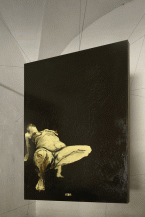
Denis Senegačnik
"Bloody Mary" Magical Unattractiveness
Lapidarium, 16.9.2011 - 06.11.2011
„The hanging of the paintings in the Kostanjevica lapidarium has been done in accordance with the artist’s own design, oriented in the first place towards connections and dialogues with individual spaces within the existing space. Through his nterventions he combines all of these in a common image composed of individual constituent units which receive different degrees of emphasis,“ as observed by curator and author of the essay accompanying the catalogue, Milena Koren Božiček, MA,
Exhibition is a result of collaboration between Božidar Jakac Art Museum and Velenje Gallery.
2010
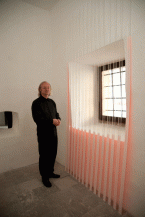
Oto Rimele
Paintings
Lapidarium, 24.09.2010 – 12.12.2010
The Paintings exhibition in the Kostanjevica Monastery offers the visitors an experience of a sombre place in which colours start to glow when one sink into a deep contemplation. It encourages the visitors to contemplain and invites them to stay alone with the light of the room. The contemplation of images, which te artist has almost deprived from their material aspect, reveals the paintings in their primeval character – as a phenomenon of pure colour and as a desire to achieve the essence of being. When the place dives into evening dusk, the colour glow intensifies and ‘brings to life hidden beauty’ as a mystic from the 5th/6th century wrote. Then, the colour glow sinks into the darkness, or ‘disappears as the light’, to use the artist’s words.
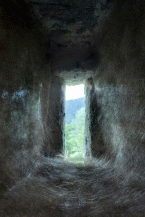
Elena Fajt
Cohabitations
Lapidarium, 21.05.2010 - 15.08.2010
Although Elena Fajt is a visual artist, her work is deeply rooted in the field of textile design. In this light, she chose cut human hair for her basic expressive medium. As it is evident in site-specific installation Cohabitatins, she continues her long-term project which she entitled Hairsenses. The artist combines hair with other materials (water, light, glass) to capture various stages of life, as perceived in our daily surrounding.
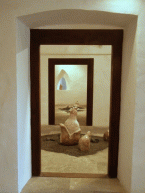
Jiři Bezlaj
Arresting the eye
Lapidarium, 09.04.2010 - 03.05.2010
Exhibition by the artist who had been studying in the sixties, the era of student protest movement, and graduated researching the influence of eastern philosophies on contemporary western modern art. Needless to say, it is the very eastern mind-sets that influenced his own sculpture. The Summer cycle, presented at the exhibition, had been evolving since 2003.
„The artists who claims to be ‘stroking’ rather than chiselling the stone, has created petrified flowers which require the viewer’s touch. It takes the palm to feel the border between smoothed and rough surfaces, sliding across smooth contours and stopping at a rough part of animal, human or vegetal body fragment. The sculptures are specifically worked by the sculptor to elicit touching – they try to establish with the viewer the kind of relationship that the sculptor had to them,“ as observed by exhibition’s curator, art historian Petja Grafenauer in the essay accompanying the catalogue.
2009
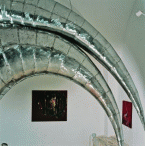
Boštjan Plesničar, Ervin Potočnik
Velvetarium - lapidarium
Lapidarium, 02.10.2009 - 31.10.2009
Boštjan Plesničar and Ervin Potočnik in their exhibition Velvetarium – lapidarium build upon the common story they set out last year with the exhibition Žametal at the Celje Centre of Modern Arts. In the lapidarium of the Božidar Jakac Gallery they attempted once again to create a dialogue between their artistic creations, one shaped radically by the archaic nature of the space.
Opening introduction and essay accompanying the catalogue had been contributed by Goran Milovanović, the exhibition’s curator.
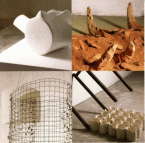
Group Exhibition
Ceramics in Concept 4/1
Lapidarium, 29.05.2009 - 31.07.2009
Mirsad Begić – Preserving Dreams
Damjan Kracina - Sanitarium
Iztok Maroh - Systems
Nataša Sedej – The Bride’s Cell
Exhibition accompanying the International Ceramic Trienale UNICUM presented artists who highlight the presence of ceramic in their conceptual art. Essay accompanying the catalogue had been contributed by Barbara Rupel, the exhibition’s curator.
2008

Karel Plemenitaš
Paths
Lapidarium, 5.9.2008 - 26.10.2008
The exhibition presented artist’s then recent series of prints, made after 2000. Prints had inhabited the space as standing objects, while sketches and drawings added value to the exhibition, illustrating artist’s mental journeys during the work process.
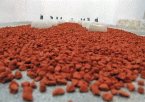
Sreten Milatović
Traces
Lapidarium, 04.07.2008 – 17.08.2008
Exhibition presented works of Sreten Milatović, participant of the Foma Viva Symposium 2004.
Stone-granite and limestone, materials which presented sculptures were made from, had been collected by Milatović in the vicinity of his hometown Nikšić and represent the main topographic poetic foundation, through which the artist extracts mental and emotional artefacts according to the material’s physical and morphological composition and connects universal values with the genius loci. Opening introduction and essay accompanying the catalogue had been contributed by Goran Milovanović, the exhibition’s curator.
Opening programme featured saxophonist Cene Resnik and guitar player Igor Bezget.
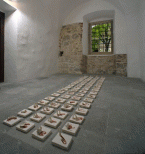
Iztok Maroh
Allusions
Lapidarium, 16.05.2008 - 22.06.2008
In the words of curator Barbara Rupel who contributed accompanying essay in the catalogue,
„the exhibition proves Iztok Marof, who selected ceramics for his initial and primary vehicle of expression, as one of the most determined contemporary artists in Slovenian milieu, as well as globally“. The exhibition consisted of seven different successive site-specific installations, all tackling the topic of allusion.
2007
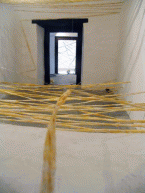
Anda Klančič
Thoughts
Lapidarium, 12.10.2007 - 25.11.2007
As exhibition’s curator Barbara Rupel observes in the essay accompanying the catalogue, „the conceptual starting point of her current exhibition is human thought … She had chosen a theme that she stripped bare on the basis of her own observations and perceptions, and at the same time with the thought of ‘everyman’ among us.“
Opening programme featured Lado Jakša, performing the music created especially for the exhibition.

Dušan Tršar
Life in space
Lapidarium, 11.05.2007 – 24.06.2007
Painting exhibition of „Anthropomorphic tree-shaped figures“, as curator Jure Mikuž observed in the essay accompanying the catalogue.
2006
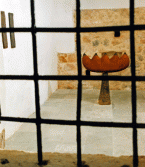
Naca Rojnik
Something in, something out and something for
Lapidarium, 21.09.2006 - 12.11.2006
Site-specific installation in Lapidarium of Božidar Jakac Art Museum presents sculptures ‘which spring a vitality that drowns out aesthetic and content assumptions’, as stressed in the essay accompanying the catalogue by Milena Zlatar, director of Koroška Art gallery
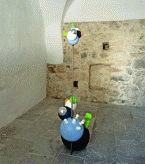
Boštjan Drinovec
Forty-Eight Times around the World
Lapidarium, 28.06.2006 - 03.09.2006
Sculpture exhibition of the artist who, in his creative efforts, „combines figures with elements of modern sculpture, constructivism, pop-art, modernism and contemporary trends“. Opening introduction and essay accompanying the catalogue had been contributed by Katja Ceglar, the exhibition’s curator.
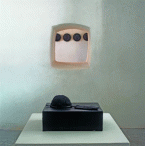
Antonija Balić Šimrak
Stranded
Lapidarium, 02.06.2006 - 16.07.2006
„The objects, linked together into a spatially complete installation entitled ‘Stranded’, look like things that we know but have never seen,“ as Marko Košan, director of Carinthian Regional Museum, referred to the author and her work in the essay accompanying the catalogue. Opening speech had been contributed by dr. Mario Nobilo, ambassador of Republic of Croatia in Slovenia.
2005
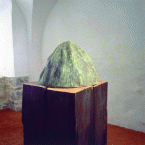
Tanja Smole Cvelbar
Material
Lapidarium, 14.10. 2005 - 30.11. 2005
Artistic installation
In the words of exhibition’s curator Barbara Rupel, „the artist had chosen artistic installation to tell us a story about clay or, better, about the mysteries of the reification of earth (the clay pit).“
Opening programme featured LeonzMinko Duet (voice and guitar: Leon Matek, voice and accordion: Hazemina Đonlič)
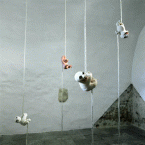
Urša Toman
The Sun was a Green Egg
Lapidarium, 15.04.2005 - 19.06.2005
In the site-specific installation, the sculptor exhibited three series of her works created between 2000 and 2005: Trilobites, Hobbits and Monsters. Opening introduction and essay accompanying the catalogue had been contributed by Katja Ceglar, the exhibition’s curator. The exhibition opening had been performed by deputy mayor of Krško municipality, Ana Nuša Somrak.
The opening programme featured clarinet quartet Clarifour.
2004
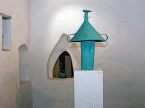
Petar Dolić
Sculptures
Lapidarium, 03.09.2004 – 31.10.2004
Using dynamic forms which were distinctly organic in origin, Petar Dolić, a younger generation sculptor from Croatia, builds his sculpture with recognisable and original shapes. Opening introduction and essay accompanying the catalogue had been contributed by art historian and critic Milan Bešlić, the exhibition’s curator.
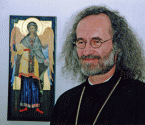
Mihajlo J. Hardi
Icons
Lapidarium, 18.06.2004 - 29.08.2004
Exhibition presented icons created by eparchy priest from Križevci. Accompanying programme featured presentation of Žumberak’s Greek Catholic history. Essay accompanying the catalogue had been contributed by Jure Zečević, PhD, lecturer of eastern liturgics at the Catholic Theological Faculty, Zagreb. Accompanying programme featured St. Cyril and Method Choir from Zagreb.
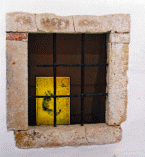
Dušan Podgornik
Breathing
Lapidarium, 21.05.2004 - 15.06.2004
Exhibition of then recent works by painter, graphic artist, photographer and designer. Exhibition catalogue had been published by Insula fine Artists Society in collaboration with the Coastal Galleries Piran and Božidar Jakac Art Museum, Kostanjevica na Krki. The catalogue contains texts by Dejan Mehmedovič, Andrej Medved and Katja Ceglar, who also introduced artist at the exhibition opening.
2003
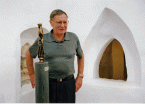
Slavko Krajnc
Sculptures
Lapidarium, 06.06.2003 - 31.08.2003
Retrospective exhibition. Opening introduction and essay accompanying the catalogue had been contributed by Marijan Tršar.
2002
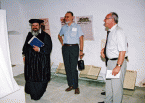
Growing Book
Lapidarium, 21.06.2002 - 22.09.2002
Exhibition presented literary sources documenting evolution of Slovene culture and knowledge. Curated by Mihael Glavan, PhD. Designed and installed by Dušan Pogornik. Exhibition opening marked the celebration of Slovenian Statehood Day. Jubilee speech had been delivered by Tone Hrovat, president of the RS National Council. Project had been introduced by Tatjana Fink, president of the Growing Book Association, while the exhibition had been presented by its curator, Mihael Glavan, PhD. accompanying programme featured Šentjernej Octet.
2001
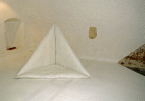
Vlasta Žanić
Spaces
Lapidarium, 01.06.2001 - 31.07.2001
Site-specific installation by Croatian artist, ‘a series of seven interventions in seven rooms’. Essay accompanying the catalogue had been contributed by Borivoj Popovčak. Opening speech had been delivered by Croatian Minister of Culture, Antun Vujić, PhD.
2000

Mojca Smerdu
Sculptures
Lapidarium, 19.05.2000 - 31.08.2000
Site-specific installation situated in the lapidarium and at the courtyard of Božidar Jakac Art Museum. Author’s work was introduced by art critic Andrej Medved. Accompanying programme featured Boris Cavazza.
Joint project of the Božidar Jakac Art Museum and the Coastal galleries, Piran.

